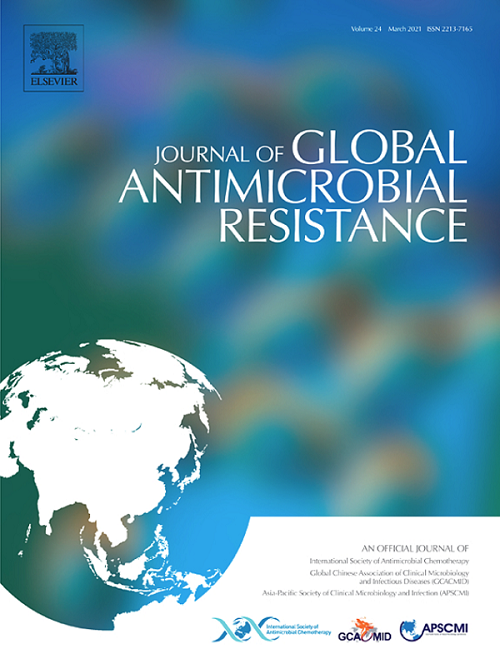In vitro characterization of PHICD111_20024_EAD as an engineered endolysin against Clostridioides difficile
IF 3.2
3区 医学
Q2 INFECTIOUS DISEASES
引用次数: 0
Abstract
Objective
Clostridioides difficile is a Gram-positive, spore-forming obligate anaerobe that can cause symptoms such as diarrhoea and abdominal cramping and lead to conditions including pseudomembranous colitis. The mainstay treatment of C. difficile infection (CDI) is antibiotics; however, antibiotics-induced gut microbiota dysbiosis poses a potential risk for refractory CDI and increased CDI recurrences. Recently, there has been growing interest in bacteriophages and their lytic enzymes as alternatives to antibiotics. We aimed to develop an engineered endolysin to specifically inactivate C. difficile.
Methods
Endolysins are bacteriolytic enzymes that facilitate the release of phage progeny during the final stage of infection. We previously demonstrated that CD27L_EAD, an engineered endolysin, inactivated C. difficile in a co-culture model of human gut microbiota. This study modified the ΦCD111 endolysin to PHICD111_20024_EAD by cleaving the cell wall-binding domain and characterized its catalytic activity in comparison with CD27L_EAD.
Results
PHICD111_20024_EAD shows high sequence similarity with CD27L_EAD. However, PHICD111_20024_EAD exerted superior bacteriolytic activity compared to CD27L_EAD under high salt concentrations. PHICD111_20024_EAD and CD27L_EAD displayed similar overall structures, consisting of five α-helices and six β-strands, and were superimposed with a zinc ion at the active site, suggesting that both enzymes are zinc-dependent N-acetylmuramoyl-l-alanine amidases. However, their binding affinities for zinc ions differed, and excess zinc ions inhibited the catalytic activity of PHICD111_20024_EAD.
Conclusions
For feasible applications of endolysins in dynamic gut environments, PHICD111_20024_EAD, which is tolerant to high osmolarity and can be modulated using zinc concentrations, provides advantageous attributes for developing therapeutic agents against CDI.

PHICD111_20024_EAD抗艰难梭菌工程酶体外特性研究
目的:艰难梭菌是一种革兰氏阳性,形成孢子的专性厌氧菌,可引起腹泻和腹部痉挛等症状,并导致包括假膜性结肠炎在内的疾病。艰难梭菌感染(CDI)的主要治疗方法是抗生素;然而,抗生素引起的肠道菌群失调对难治性CDI和CDI复发率增加有潜在的风险。最近,人们对噬菌体及其裂解酶作为抗生素的替代品越来越感兴趣。我们的目标是开发一种工程内溶素来特异性灭活艰难梭菌。方法:内溶素是一种在感染末期促进噬菌体子代释放的溶菌酶。我们之前证明了CD27L_EAD,一种工程内溶素,在人类肠道菌群共培养模型中灭活艰难梭菌。本研究通过裂解细胞壁结合结构域将ΦCD111内溶素修饰为PHICD111_20024_EAD,并与CD27L_EAD比较其催化活性。结果:PHICD111_20024_EAD与CD27L_EAD具有较高的序列相似性。而PHICD111_20024_EAD在高盐浓度下表现出比CD27L_EAD更强的抑菌活性。PHICD111_20024_EAD和CD27L_EAD的整体结构相似,由5个α-螺旋和6个β-链组成,并且在活性位点叠加了一个锌离子,表明两者都是锌依赖性n -乙酰muramyl - l-丙氨酸酶。然而,它们对锌离子的结合亲和力不同,过量的锌离子抑制了PHICD111_20024_EAD的催化活性。结论:PHICD111_20024_EAD具有高渗透压耐受性,可通过锌浓度调节,为开发抗CDI治疗药物提供了有利条件,可在动态肠道环境中应用内溶素。
本文章由计算机程序翻译,如有差异,请以英文原文为准。
求助全文
约1分钟内获得全文
求助全文
来源期刊

Journal of global antimicrobial resistance
INFECTIOUS DISEASES-PHARMACOLOGY & PHARMACY
CiteScore
8.70
自引率
2.20%
发文量
285
审稿时长
34 weeks
期刊介绍:
The Journal of Global Antimicrobial Resistance (JGAR) is a quarterly online journal run by an international Editorial Board that focuses on the global spread of antibiotic-resistant microbes.
JGAR is a dedicated journal for all professionals working in research, health care, the environment and animal infection control, aiming to track the resistance threat worldwide and provides a single voice devoted to antimicrobial resistance (AMR).
Featuring peer-reviewed and up to date research articles, reviews, short notes and hot topics JGAR covers the key topics related to antibacterial, antiviral, antifungal and antiparasitic resistance.
 求助内容:
求助内容: 应助结果提醒方式:
应助结果提醒方式:


